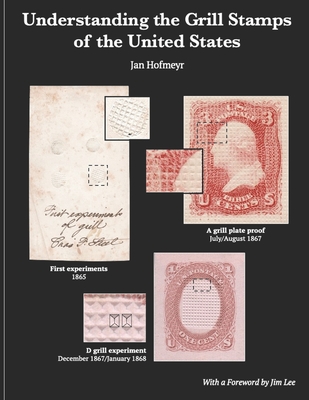Understanding the Grill Stamps of the United States

Understanding the Grill Stamps of the United States
Between 1867 and 1871, the United States Post Office issued what are known as "grill" stamps. that is, stamps printed on embossed paper to stop people from reusing them. Today they are among the most expensive stamps in the world. The catalogue value of the 1c Z grill, for instance, is $3.5 million. So, how did this happen?
This book tells the story of the "grills" - how they came to be, the stresses that led up to them, the reasons they took the shapes that they did; and the reasons for their ultimate failure. Using archival letters and documents that haven't been available to the public until recently, "Understanding the Grill Stamps of the United States" is the first complete story of the "grills."In 1867 and 1868, the United States produced some of the most expensive postage stamps in the world - the grills. Based on a patent by Charles Steel, they were an attempt to produce stamps that could only be used once. This book is their story. This book is complete. The first two chapters set the scene by describing the factors in the 1860's that caused the USPO to look for a stamp that could not be cleaned and reused. Chapter 3 is a detailed summary of previous scholarship, from Tiffany's first published description of the stamps in 1887, through Stevenson's brilliant analysis of what there is and how it might have been produced (1915), to Herzog's comprehensive catalogue (1978) and Bishop's argument that there must have been two grillining mechansisms for what are currently known as the Z grills (2020). Chapters 4 and 5 are entirely original. They answer the question "why" - why did the USPO go with Steel's patent, how were the stamps supposed to work, and why did they fail. It is based on a). an in depth study of the patent itself, b). Steel's essay experiments, and c). the archival correspondence that led eventually to the stamps. An appendix contains all relevant known archival documents.
PRP: 387.50 Lei
Acesta este Prețul Recomandat de Producător. Prețul de vânzare al produsului este afișat mai jos.
348.75Lei
348.75Lei
387.50 LeiIndisponibil
Descrierea produsului
Between 1867 and 1871, the United States Post Office issued what are known as "grill" stamps. that is, stamps printed on embossed paper to stop people from reusing them. Today they are among the most expensive stamps in the world. The catalogue value of the 1c Z grill, for instance, is $3.5 million. So, how did this happen?
This book tells the story of the "grills" - how they came to be, the stresses that led up to them, the reasons they took the shapes that they did; and the reasons for their ultimate failure. Using archival letters and documents that haven't been available to the public until recently, "Understanding the Grill Stamps of the United States" is the first complete story of the "grills."In 1867 and 1868, the United States produced some of the most expensive postage stamps in the world - the grills. Based on a patent by Charles Steel, they were an attempt to produce stamps that could only be used once. This book is their story. This book is complete. The first two chapters set the scene by describing the factors in the 1860's that caused the USPO to look for a stamp that could not be cleaned and reused. Chapter 3 is a detailed summary of previous scholarship, from Tiffany's first published description of the stamps in 1887, through Stevenson's brilliant analysis of what there is and how it might have been produced (1915), to Herzog's comprehensive catalogue (1978) and Bishop's argument that there must have been two grillining mechansisms for what are currently known as the Z grills (2020). Chapters 4 and 5 are entirely original. They answer the question "why" - why did the USPO go with Steel's patent, how were the stamps supposed to work, and why did they fail. It is based on a). an in depth study of the patent itself, b). Steel's essay experiments, and c). the archival correspondence that led eventually to the stamps. An appendix contains all relevant known archival documents.
Detaliile produsului









